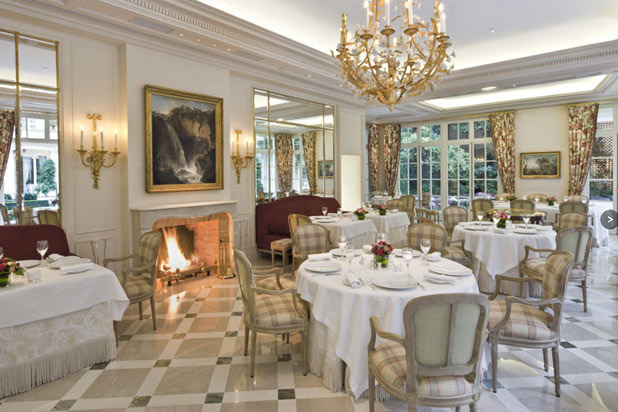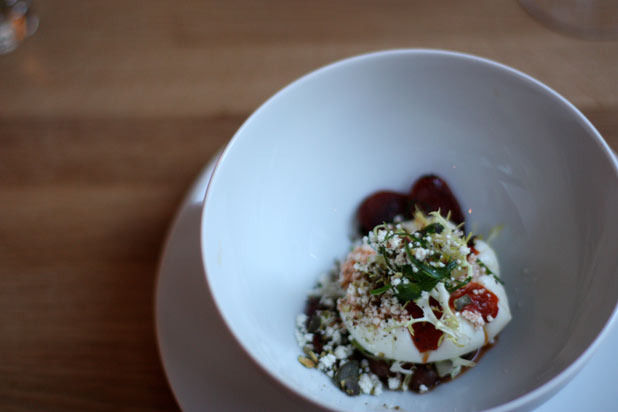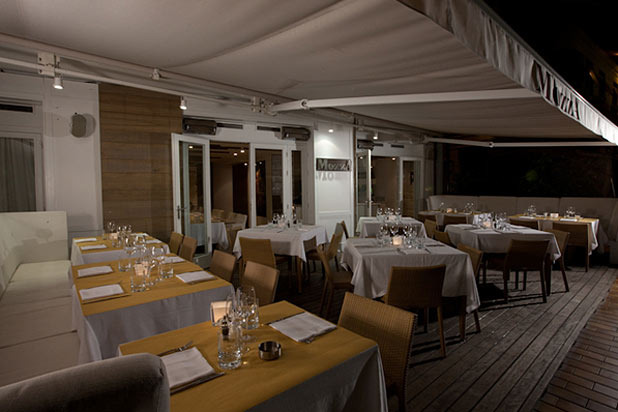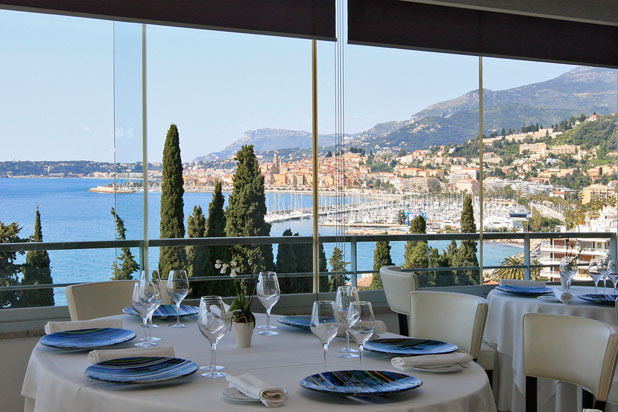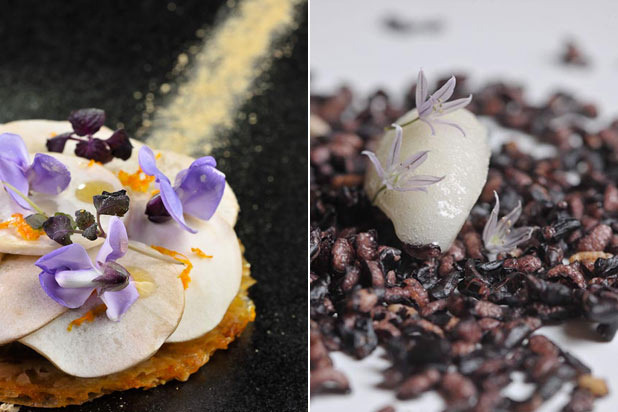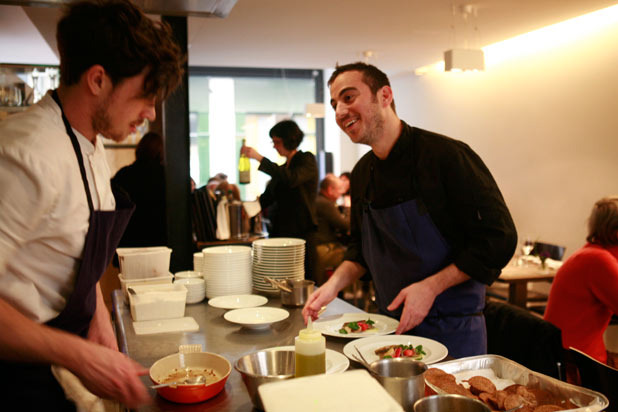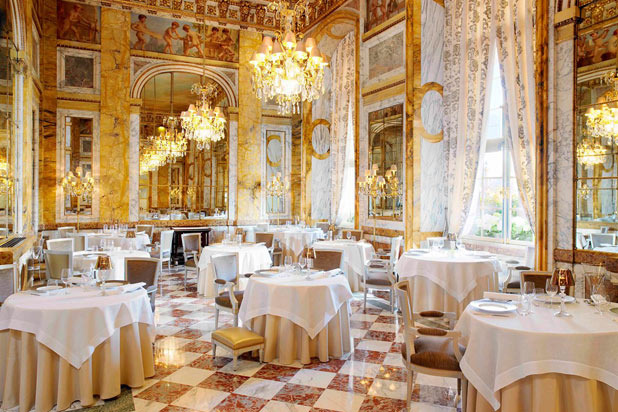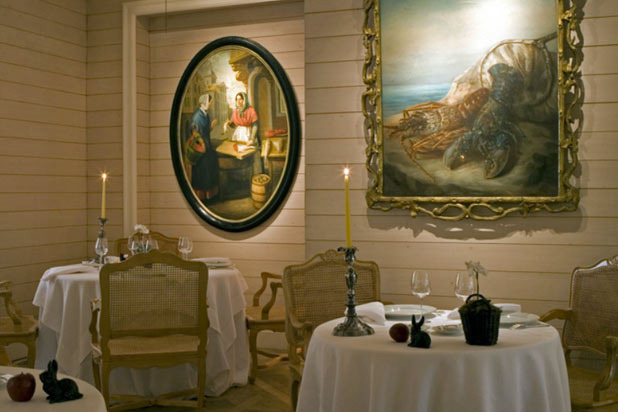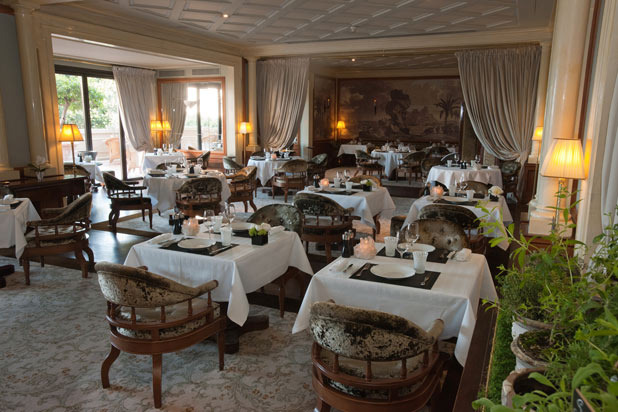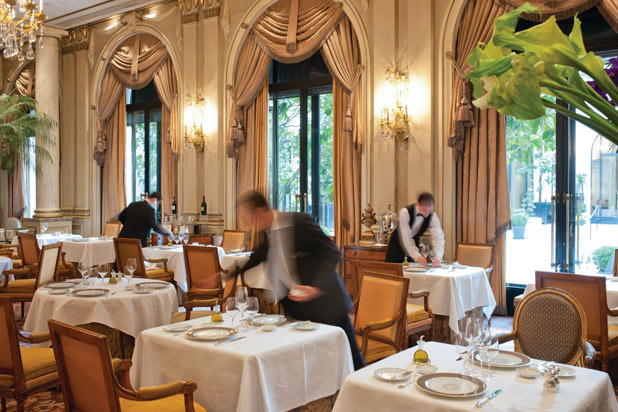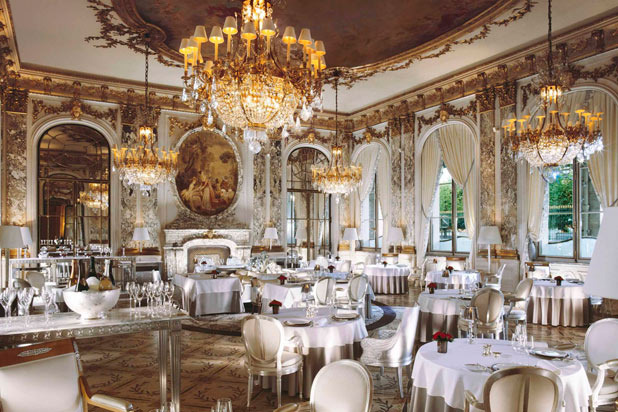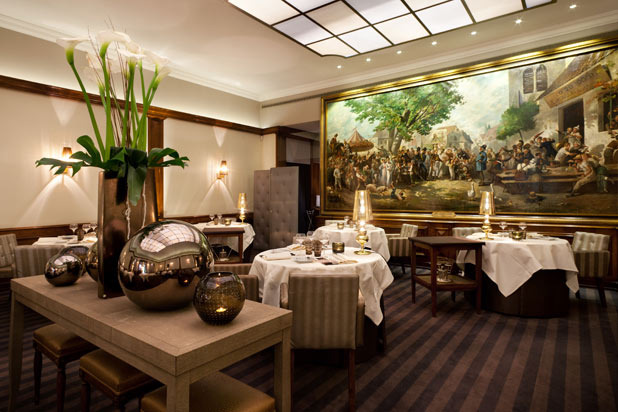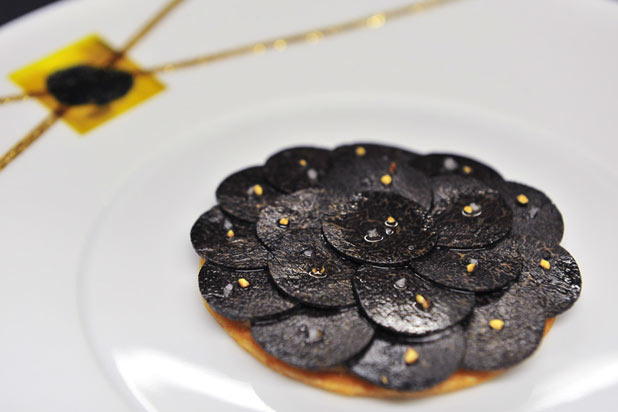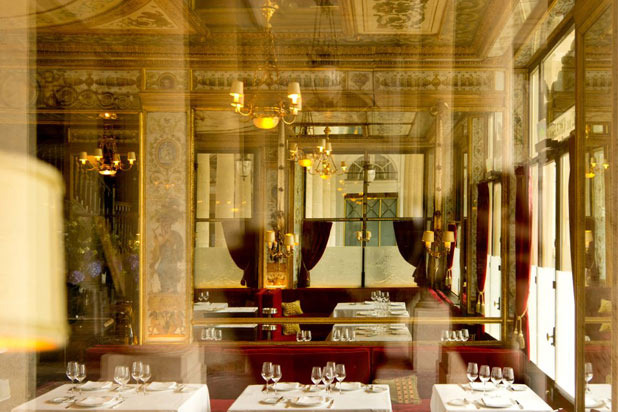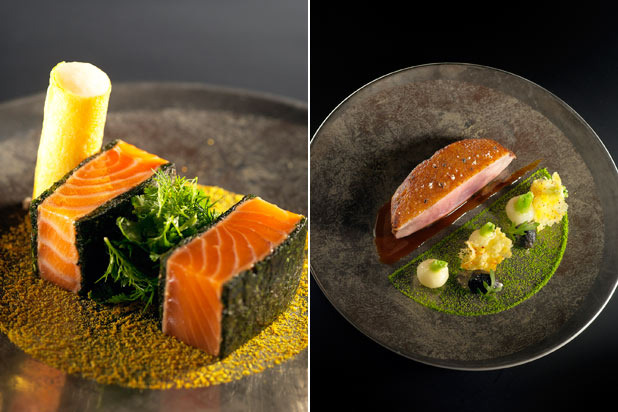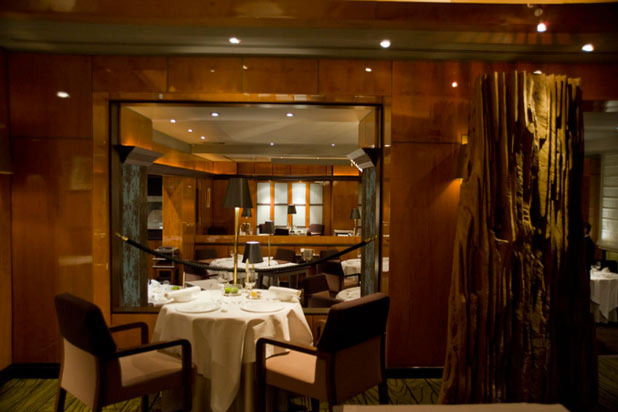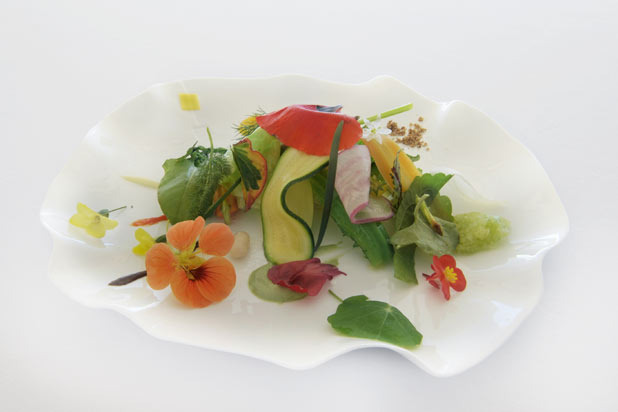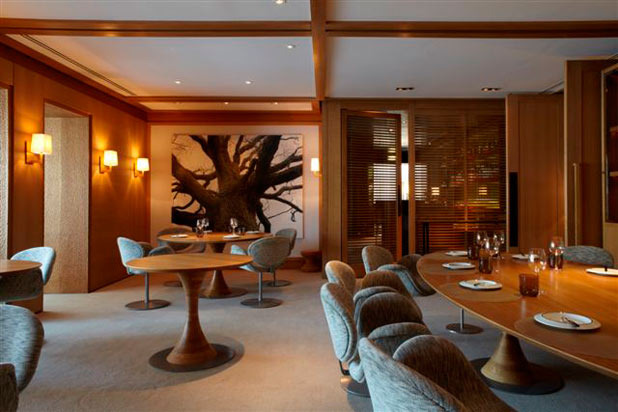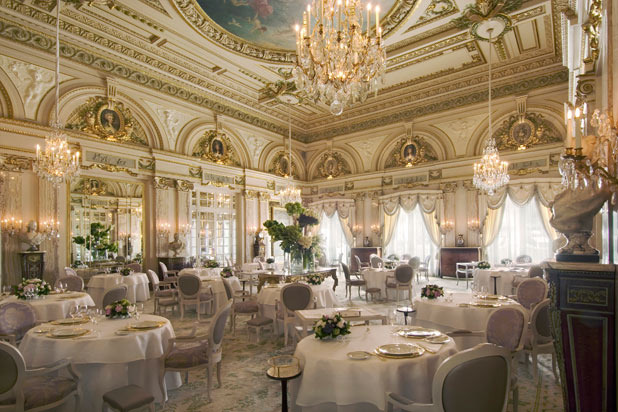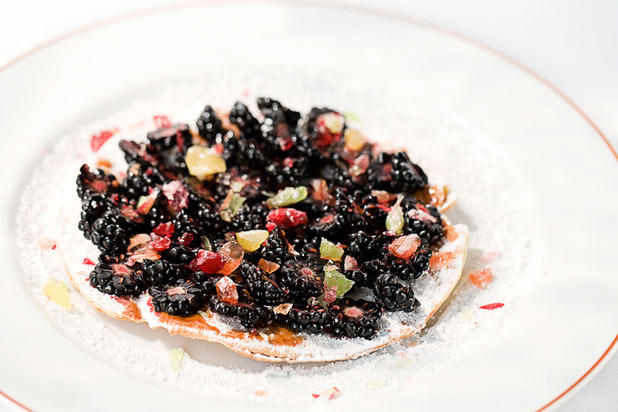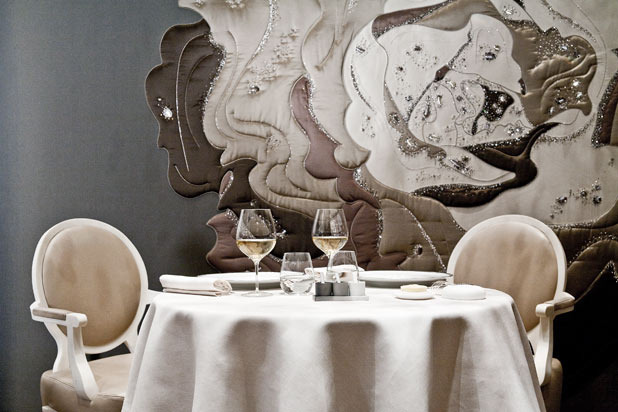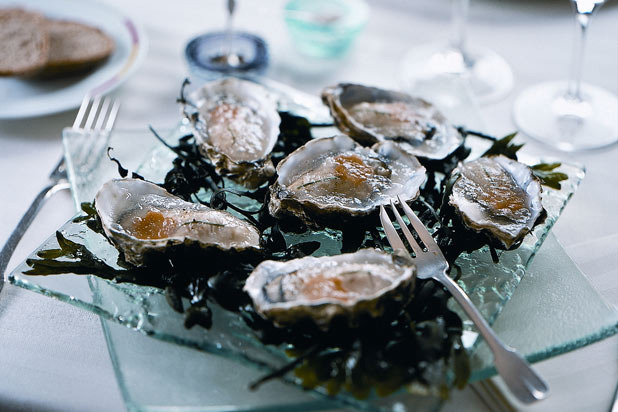25 Best Restaurants In France And Monaco Slideshow
Located in the picturesque Relais Saint-Germain Hotel in the heart of Paris, Le Comptoir is a tiny bistro featuring the cuisine of "bistronomy" pioneer Yves Camdeborde. His bargain-priced, no-choice, multi-course evening menu has made a dinner reservation here one of the hardest to get in town. (Recent dishes included shrimp ravioli in basil broth with vinegar pearls; hearts of palm with smoked salmon and Avruga caviar; and Mediterranean bluefin tuna with ginger, vegetables, and Cambodian pepper.) At lunchtime, no reservations are taken and the large à la carte menu offers a wide range of traditional fare, from house-made pâtés and terrines to boudin and entrecôte.
24. Epicure at Le Bristol (Paris)
At the three Michelin-star Epicure, chef Eric Frechon lives up to his reputation as one of the best chefs in town with dishes like langoustines and caviar with celeriac and Japanese lemon; stuffed macaroni with black truffle, artichoke, foie gras, and grated mature Parmigiano; line-caught whiting fish in a crust of bread with almonds; veal sweetbreads braised with amaretto and red onion confit; and gilded Nyangbo chocolate with liquid cocoa. In wintertime, the restaurant occupies a remodeled interior dining room lit by decadent gold chandeliers; in warmer weather, the action shifts to a salon enclosed with windows giving onto the hotel's French garden.
23. Verjus (Paris)
Here's a movie plot you don't see often: American chef opens his first restaurant in Paris and wins over French patrons. One of those "it would never happen in real life" stretches of the imagination, right? Not so for New Orleans-born, Boston-bred chef Braden Perkins, whose fresh, seasonal fare has been getting buzz suggesting that maybe Paris can start culinary trends again (it was even described in a recent Saveur review as having "un vibe très Brooklyn"). The dinner-only tasting menu at Verjus changes almost daily. With dishes like milk-fed veal from Ossès with kombu, fava, and ricotta dumplings, the food may not be French per se, but its ideology fits squarely within Paris' resurgent bistro cuisine.
22. Mozza (Monte Carlo)
Mozza is easily the best Italian restaurant in Monaco — which, remember, is less than 10 miles from the Italian border. Though the restaurant, which features a terrace for dining outdoors in the summer months, is closing for renovation on Oct. 15, the most popular dishes on the menu are expected to remain. Patrons can order a selection of mozzarella campana to begin, which includes choices like bufala mozzarella, bufala ricotta, and burrata, or opt for the tirasugo with lobster, potatoes, cream, and leeks; the Mozza basket of arancino, panzerotti, and mozzarella in carrozza; or the fish of the day.
21. Mirazur (Menton, France)
At two-Michelin-starred Mirazur, chef Mauro Colagreco procures the freshest ingredients from local markets. The Argentinean-born chef of Italian and Spanish descent has created a menu that is an exquisite take on basic French cuisine, with options like mildly grilled San Remo red prawns served with wild strawberries, borage, fennel, hyssop, and yarrow; white asparagus with hazelnuts and black sesame seeds; and sea bass with sorrell and smoke foam — all garnished with tiny herbs and blossoms from the restaurant garden.
20. Le Carré des Feuillants (Paris)
The original Feuillants were a group of moderate Jacobins during the French Revolution who congregated on the rue Saint-Honoré, near what is now Alain Dutournier's jewel box of a restaurant off the Place Vendôme. Dutournier's first Paris restaurant, Au Trou Gascon, celebrates the flavors and hearty specialties of his native Gascony. The cooking at Le Carré des Feuillants keeps an earthy richness but is more refined. Consider such creations as "half-cooked" wild salmon with marinated and smoked ceps, young partridge and truffle pie with foie gras and hazelnuts, roasted lamb with watercress and eggplant lasagna, and caramelized figs with ginger, walnut crisp, sheep's milk cheese, and lemon sorbet. There are those who think that this stylish restaurant deserves three Michelin stars (it currently has two), and we'd have no problem with that at all.
19. L'Atelier de Jean-Luc Rabanel (Arles, France)
At his small, sleekly modern restaurant in the handsome Provençal city of Arles, Jean-Luc Rabanel pays tribute to vegetables with flair and good sense. Fish and meat aren't absent from his menu, but he conceives his dishes vegetable-first. He is a good technician, but his creations tend to have a spirit that seems more artisanal than technical. Recent specialties include baby carrot tempura with peanut sauce and sweet peppers confit with ginger; Thai-marinated raw tuna with polenta and crunchy vegetables; soufflé of red Camargue rice with chilled ajo blanco; cold sardine consommé with dashi, verbena gelée, and sardines en escabeche; and confit of striped beets with milk ice and vanilla-scented vinaigrette.
18. Spring (Paris)
The chef behind this Parisian hot spot is Chicagoan Daniel Rose who creates seasonal three- and four-course prix fixe menus that change weekly. Among the offerings earlier this year were green peas with asparagus wrapped in Spanish ham in citrus sauce, crisp-skinned squab with foie gras, and Greek yogurt with crushed pistachios. Reservations are essential, though occasionally diners can walk in and get a table. When booking a table at Spring, which is just steps from the Louvre, request a wine tasting in the 16th-century wine cave prior to dinner.
17. Les Ambassadeurs (Paris)
There's no mistaking what kind of experience you're about to go in for when you sit down at Les Ambassadeurs: high-end food in high style. The ornate, shiny dining room was once the grand ballroom of the Hôtel de Crillon, built by Ange-Jaques Gabriel for King Louis XV in 1758. Golden hues, crystal chandeliers, huge mirrors, marble, and 25-feet high ceilings — it's a regal setting for 29-year-old chef Christopher Hache's cuisine). Having garnered a Michelin star last year will likely raise the bar for dining experiences to come.
16. Les Prés d'Eugénie (Eugenie-les-Bains, France)
Michel Guérard, one of the founders of nouvelle cuisine (and the founder of its low-cal cousin, cuisine minceur — thinning cuisine), moved from his restaurant in a Paris suburb to his wife's family's leafy spa estate in southwestern France in the mid-1970s, and soon established his restaurant there as one of the musts on any gastronomic pilgrimage. The location is supernally bucolic, the dining rooms are light and airy, and the food is elegant and sure-handed. Expect to feast on such specialties as foie gras en cocotte with Pomerol gelée and Asian spices, steamed crab with vegetable risotto, rack of lamb with sweet onions and white bean ragout, and garden strawberries with herb sorbet. And cheese lovers can't miss the selection of three different Roqueforts, sliced paper-thin at the table with intriguing guillotine-like contraptions.
15. Restaurant Joël Robuchon at Hotel Métropole (Monte Carlo)
Legendary French chef Joël Robuchon's Mediterranean-accented Restaurant Joël Robuchon serves his signature cuisine in an intimate dining room accented with warm tones and wood. Book a seat at the eight-seat Joël Robuchon's Table, the chef's version of a table d'hôte. Head chef Christophe Cussac creates a four-course "discovery menu" from the open teppanyaki-style kitchen, which includes such fare as caramelized quail stuffed with foie gras and served with mashed potatoes, and sea bass fillet with ceps and eggplant sauce.
14. Le Cinq at the Four Seasons Hotel George V (Paris)
Le Cinq's spacious dining room, awash in soft tones of gold and gray, from the sumptuously appointed fabric walls to the gold embossed velvet armchairs, exudes opulence. Refined French cuisine is served on white Philippe Deshoulières china bearing a reproduction of the emblematic cameo that adorns the top of each of the two-Michelin-starred restaurant's walls. Executive chef Eric Briffard and his team of 70 cooks create seasonal menus that include such delights as Brittany spider crab with caviar and fennel blanc mange, giant red shrimp with black rice and fava beans, teriyank-grilled Iberian pork loin with ginger-breaded pig's feet and mashed potatoes, and candied pink rhubarb with Fontainebleau cheese and raspberries. Award-winning wine director Eric Beaumard has compiled an impressive wine cellar with 40,000 bottles, nestled almost 50 feet below ground in what used to be an old stone quarry, used in part to build the Arc de Triomphe. Beaumard's oldest bottle is an 1850 Madeira.
13. Restaurant Le Meurice at Le Meurice Hotel (Paris)
Chef Yannick Alléno, who holds the ultimate culinary accolade of three Michelin stars, has left no detail overlooked at Restaurant Le Meurice, from his seasonally changing menus to the Ondes tableware which he has designed himself. Philippe Starck redesigned the interior in 2007, inspired by the Salon de la Paix at the Château de Versailles. Think chandeliers, gilded glass doors, frescos, and stunning views of the Tuileries Gardens. To suit this elegance, Alléno has carefully crafted dishes like langoustine fricassée with zucchini, chanterelle mushrooms, almond milk, and orange blossom and "biscuit" of chicken breast from Bresse poached in champagne broth with a cassolette of dumplings, girolles, and duck foie gras.
12. L'Astrance (Paris)
You never know what you're going to sit down to eat at L'Astrance, and to a degree, neither will the chef (there's no set menu) until you note some of your own likes and dislikes. The discreet restaurant named for a flower that grows in the chef's native Auvergne (central France) and located not far from the Eiffel Tower, is the work of Christophe Rohat and Pascal Barbot, two former employees of three-Michelin-star chef Alain Passard (L'Arpège). Chef Barbot's modern French cuisine takes the form of some 15 tastes that are thought up based on the best products he can find, and what he learns of your own preferences. Think French omakase, and expect some beautiful creativity.
11. Au Crocodile (Strasbourg, France)
Au Crocodile, was named for the stuffed crocodile that one of Napoléon's generals brought back from the Middle East (it now hangs in the restaurant's foyer). Chef Philippe Bohrer took over the restaurant from its renowned longtime owner-chef, Émile Jung, in 2010. Influences on his exquisite cooking range from the restaurant's home territory of Alsace to far-off India and North Africa, with such preparations as goose foie gras with green anise, black cherries, and pinot noir reduction; red mullet salad with Madras curry, tempura of comfrey (a medicinal herb) with chermoula (Moroccan spices), and peanut sauce; local farmhouse squab with gingerbread crumbs, confit carrots, lovage cappuccino, and bitter beer sauce; and mango carpaccio with saffron, chocolate, and mango-passion fruit sorbet.
10. L'Atelier Saint-Germain de Joël Robuchon (Paris)
Often called the greatest French chef of the late 20th century, Joël Robuchon "retired" from his celebrated three-star restaurant years ago — and ever since has been busier than ever. The original Paris location (there are now two) of his casual sushi-bar-style L'Atelier — one of eight in Europe, Asia, and the U.S. (the New York outpost closed earlier this year) — was so popular when it opened that no reservations were taken and there was no exterior door handle: You got in only if the door was opened from the inside, and that might be after waiting an hour or two on the sidewalk. Things have calmed down a little, but it's obvious from the crowds that fill the counters here that this style of eating has lost none of its appeal. Some of the food is tapas-like (Robuchon has a summer home in Spain), like first-class Spanish bellota ham (from acorn-fed pigs) or simple
anchovies with grilled red peppers; other dishes are more elegant, like clams stuffed with pink garlic and mushrooms or chicken in bouillon with foie gras ravioli. Everything is straightforward and based on the best raw materials, and the camaraderie of the informal service makes a meal here a casual delight.
9. Le Grand Véfour (Paris)
To dine at Le Grand Véfour is to dine in the midst of Parisian history. The first luxury restaurant in the city, it opened as Café de Chartres in 1784. It acquired its glittery over-the-top décor, full of tall gilded mirrors, crystal chandeliers, and frescoed walls, in the early 1800s, and became a gathering place for all the period's French literary and political celebrities. It closed in 1905, but its interior was preserved, and in 1947 the legendary chef Raymond Oliver reopened it. Since 1993, the chef has been Guy Martin, a Savoyard who accents his modern French cooking with exotic highlights — Sichuan pepper with his roasted lobster with white and green asparagus; bergamot with his foie gras with zucchini confit; ylang-ylang meringue with his cube of Valrhona Manjari chocolate with berries, grapefruit, and avocado (yes). On the other hand, the flavors of his parmentier de queue de boeuf aux truffes — truffled oxtail cottage pie — are pure old-fashioned French.
8. Taillevent (Paris)
The 14th-century French chef Guillaume Tirel was nicknamed Taillevent — "wind slicer" — supposedly in reference to his prominent beak. When André Vrinat opened his restaurant in Paris in 1946, he borrowed the name to suggest a connection with ancient Gallic gastronomy. His son, Jean-Claude, inherited the place 26 years later and established it as arguably the most perfectly run restaurant in France. The younger Vrinat died in 2008 and the restaurant has new owners (and only two Michelin stars instead of the three it long held), but it's as good as ever: The dining room is clubby and warm, the service is beyond accomplished, the wine list offers surprising bargains (including irresistible prices on a wide range of Raveneau chablis), and the cuisine of chef Alain Solivérès — "tradition continually renewed," which translates to such fare as spelt risotto with frogs' legs, sole with almond mousseline and verbena juice, and veal cheeks en blanquette with baby vegetables — is irreproachable.
7. Pierre Gagnaire (Paris)
Considering that he began his culinary career by turning away from the more classic cooking of his father's generation, it's funny to think that today Pierre Gagnaire is considered amongst the old guard of France's most respected chefs. From Michelin darling to bankruptcy, and back to the top again with what many consider to be one of the world's best restaurants, Gagnaire has done it all — even opened a restaurant (one of his total 11) in Las Vegas. But the culinary heart of this 62-year-old icon is in his eponymous restaurant at 6 rue Balzac in Paris. The décor is calm and upscale, but unpretentious. And the cuisine is intellectual (expect lyrical, veritable menu haikus) but enjoyable, with touches of the international ingredients Gagnaire has been exploring since his early days. While he is renowned for his risk-taking, for diners there's little to worry about, just high reward.
6. Bras (Laguiole, France)
With its striking architectural profile — glass and steel, granite and slate — jutting out of a mountainside near the famous knife town of Laguiole (pronounced "layole"), Bras makes a dramatic statement: that it is both contemporary and firmly attached to the local countryside. The same is true of the cuisine of Michel Bras and now his son, Sébastien. Bras père et fils use obscure native plants, local Aubrac beef and Laguiole cheese, and local wines (principally Marcillac, based on cabernet franc and sauvignon and a regional variety called fer servadou) to produce imaginative presentations like sautéed foie gras with strawberry-Marcillac preserves, garden cress, strawberries, and green onions or saddle of lamb with sweet almonds and "all the sprouts of springtime." Not to be missed is the restaurant's most famous dish, the ever-changing gargouillou, a dish of perfectly cooked baby vegetables, grains, and herbs.
5. Maison Troisgros (Roanne. France)
The Troisgros brothers, Pierre and his late sibling Jean, were among the pioneers of France's game-changing nouvelle cuisine in the 1970s. Today, Pierre's son, Michel, runs the iconic Troisgros establishment, in the small town of Roanne, about 50 miles northwest of Lyon. The food is appealing simple, but incorporates exotic elements — tamarind "satay" with the sautéed frogs' legs, mint with the eel, kumquat and grapefruit with the caramelized Challans duckling, Earl Grey tea with the rhubarb meringue. Classic dishes from the nouvelle cuisine era, like sole with chives and young squab cooked woodcock-style, are also offered.
4. Le Louis XV at Hôtel de Paris (Monte Carlo)
When Alain Ducasse opened Le Louis XV, Prince Rainier III of Monaco set him a challenge: turn the restaurant into the first in the principality to be awarded three Michelin stars, and do it within four years. Ducasse succeeded after only three. This opulent Versailles-inspired dining room, replete with frescos, chandeliers, and velvet accents, one of three Ducasse restaurants to make The Daily Meal's 101 Best Hotel Restaurants Around the World, is celebrating its 25th anniversary this year with a special menu prepared by chefs Franck Cerutti and Dominique Lory. Included are San Remo gamberoni with delicate rock fish gelée and caviar; a Haute-Provence small spelt, morels, and spring vegetables; snapper and trombetta zucchini with condiments; suckling lamb roasted in the fireplace with peas, spring onions, green garlic, and pommes grenaille; a selection of regional goat's cheese; bitter citrus fruit with lemon jelly and grapefruit/Campari sorbet; and warm Piedmont hazelnut soufflé.
3. L'Arpège (Paris)
Alain Passard, long ensconced in the original site of his mentor Alain Senderens' epochal L'Archestrate, is a thoroughly original chef who combines tradition (he rotisserie-roasts duckling, chicken, lamb, and game birds in the style that he learned from his late grandmother, and they are among the most perfectly cooked and succulent examples of these foods that you will ever find) with daring. The latter is expressed most dramatically through the vegetable-based menu he introduced in 2001, a veritable paean to produce. His spinach with brown butter and carrots à l'orange, beets with coarse salt and quince mousseline, celery risotto with sorrel, and the like are little masterpieces that would convince you that Passard deserves his three Michelin stars even if you never tried a bite of his excellent turbot with smoked vegetables, lobster with honey and turnips, or Grandma Passard's roast duck.
2. Alain Ducasse au Plaza Athénée at Plaza Athénée Hotel (Paris)
Since re-opening in 2000, Alain Ducasse au Plaza Athénée at the Plaza Athénée Hotel in Paris has garnered the renowned Alain Ducasse three more Michelin stars to add to his list of culinary honors. Beneath a chandelier starburst of 10,000 dangling, illuminated crystal pendants is a space designed by Patrick Jouin that evokes fine dining in opulent Louis XIV style. The restaurant serves the finest seasonal contemporary French on tableware by Pierre Tachon and Shinishiro Ogata. The haute cuisine includes guinea-fowl tourte, John Dory with artichokes and arugula, sweetbreads with olives and asparagus, and fresh sheep's milk cheese with caramel and pepper. "We must let the flavors express their strength and their delicacy," said Ducasse. "The technique is there to reveal the natural taste."
1. Guy Savoy (Paris)
Arguably the best Michelin-three-star in Paris, Guy Savoy is a beautiful restaurant, comfortable and coolly elegant in design, with consistently good food in a style that might be called sensible contemporary. Savoy is a master at imagining combinations that aren't immediately obvious but that make wonderful sense. His artichoke soup with black truffles and brioche spread with truffle-mushroom butter is an example; so is his arrangement of beets of different hues with crabmeat, his lobster with cauliflower in various forms and a taste of mustard, his Bresse chicken breast with lemongrass and chard glazed with chicken stock and bay, and his terrine of grapefruit with tea sauce. The cooking is remarkably consistent here; the wines are superbly chosen and often good bargains; and the service is superb, friendly but not familiar. Guy Savoy is everything a top-level French restaurant should be.

